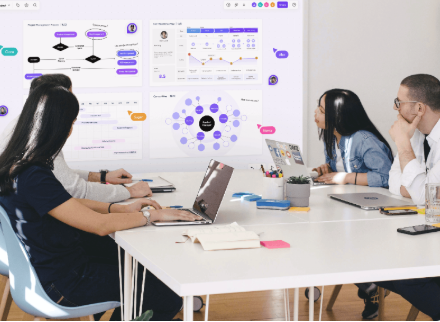Collaborative learning plays a vital role in helping students share knowledge, solve problems together, and stay motivated. Free digital study boards allow groups to brainstorm, organize study materials, and plan tasks in real time from anywhere. These tools are especially useful for group projects, peer tutoring, remote study sessions, and exam preparation. With increasing emphasis on digital literacy and teamwork, having access to reliable and user-friendly collaborative platforms is essential for academic success.
Here are some of the best free platforms that support group collaboration through interactive digital boards:
- Jamboard (jamboard.google.com) – A free digital whiteboard tool by Google that allows users to draw, write, add sticky notes, and insert images collaboratively. Perfect for real-time brainstorming, concept mapping, organizing study topics, or planning group assignments. It integrates seamlessly with Google Workspace, making it ideal for students using Google Docs, Slides, and Classroom. Its intuitive interface makes it accessible for younger learners and higher education students alike.
- Miro (miro.com) – A powerful online whiteboard platform with a generous free plan for educational use. It includes templates for SWOT analysis, project timelines, brainstorming maps, and study workflows. Students can use Miro to plan group presentations, build revision roadmaps, or create visual aids. Real-time editing, sticky notes, commenting, timers, and chat features make it a well-rounded tool for any study team.
- Padlet (padlet.com) – A flexible board tool that allows students to post text, images, links, videos, voice notes, and documents on a shared wall. Padlet offers different board formats like grids, timelines, and maps, which are helpful for various academic tasks. It’s great for collaborative discussions, peer feedback, group reflections, and collecting diverse resources in one place. Students can also embed Padlets into websites or share them with their class for broader engagement.
- Trello (trello.com) – While originally designed as a task manager, Trello’s board and card system is ideal for managing collaborative study projects. Each card can contain checklists, attachments, comments, and due dates. Trello is perfect for assigning group roles, tracking individual contributions, and organizing research phases. It’s especially helpful when collaborating asynchronously across different schedules.
- Whiteboard.fi (whiteboard.fi) – A free tool that provides individual whiteboards for each student, visible to the group leader. It’s useful for quick check-ins, solving math problems, or comparing ideas in real time. Teachers or study leaders can monitor everyone’s contributions and provide guidance instantly. It works well for small groups practicing problem-solving and formative assessments.
- Microsoft Whiteboard (whiteboard.microsoft.com) – An intuitive digital canvas integrated with Microsoft Teams and Office 365. Students can sketch diagrams, annotate documents, insert images, and work simultaneously on shared projects. With features like text boxes, templates, and version history, it supports both creative and structured collaboration.
- Lucidspark (lucidspark.com) – Offers a visual brainstorming space with tools like sticky notes, freehand drawing, shapes, and voting. It encourages participation with activity timers and breakout areas. Lucidspark is excellent for organizing group debates, designing review guides, or preparing group projects. Its integration with Lucidchart also allows for transition from brainstorming to formal presentation.
- Conceptboard (conceptboard.com) – A visual collaboration platform that supports PDFs, image annotation, sticky notes, and drawing tools. With its version history, live cursors, and chat, it is ideal for media-heavy group assignments, design projects, or reviewing academic articles together. Conceptboard’s real-time feedback features support peer review activities and content planning.
- Groupboard (groupboard.com) – A lightweight, browser-based collaborative whiteboard that requires no downloads. Students can sketch, type, and brainstorm ideas freely. It’s best suited for quick ideation sessions, simple mind maps, or spontaneous study check-ins. Its simplicity makes it ideal for younger learners or tech-shy users.
- FigJam by Figma (figma.com/figjam) – A modern, visually engaging collaboration tool where students can ideate using sticky notes, emojis, diagrams, flowcharts, and voting widgets. FigJam’s real-time design thinking features make it fun and effective for digital learners. It supports synchronous and asynchronous collaboration, making it a versatile tool for planning, organizing, and reflecting.
Additional Study Use Cases for Digital Boards:
- Creating collaborative vocabulary walls for language learners
- Building visual timelines for history or literature reviews
- Organizing lab results or scientific observations
- Designing storyboards for creative writing and film studies
- Practicing collaborative problem-solving in math or coding challenges
- Gathering and organizing research sources for group reports
Best Practices for Using Digital Study Boards:
- Assign roles: Designate clear responsibilities such as facilitator, note-taker, researcher, and presenter.
- Set goals: Define specific learning outcomes or tasks before each session.
- Use visuals: Enhance communication with colors, arrows, icons, and diagrams.
- Document progress: Export or screenshot boards for review and reference later.
- Promote equity: Rotate roles and encourage balanced participation from all group members.
- Leverage templates: Use pre-made templates for common academic structures like SWOT analysis, KWL charts, or Cornell Notes.
Conclusion:
Free digital study boards offer students a shared space to collaborate, visualize information, and communicate ideas effectively. These platforms enhance the group learning experience by fostering creativity, accountability, and real-time interaction. From brainstorming sessions to project planning, digital boards allow learners to organize knowledge in ways that align with their goals and academic styles. Whether working remotely or face-to-face, students benefit from these intuitive and engaging resources that support teamwork, organization, and deeper understanding across all subjects and grade levels.














